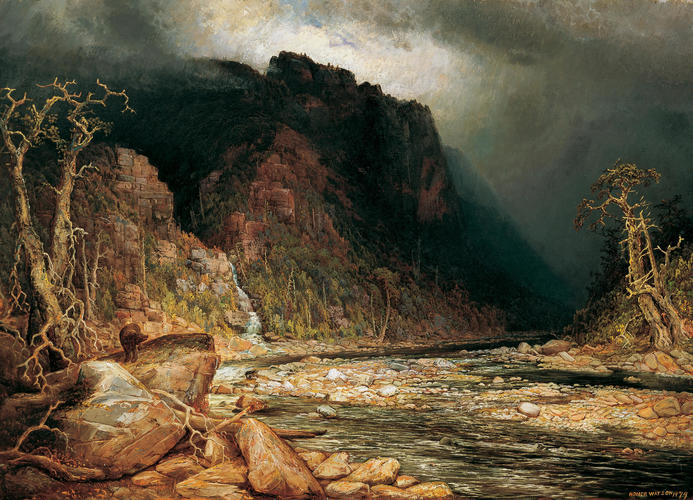The landscape painter Homer Watson (1855–1934) returned home to Doon, Ontario, in 1877 after an extended tour of New York State, where he had painted various small landscapes that carried traces of the work of the Hudson River School of landscape painters. He later recalled of those months: “I got so impatient to rush back home and use all this knowledge that I could not stay . . . any longer.” Although he was eager to paint the familiar landscapes of Doon, Watson also took time to transfer some of his American memories onto canvas.

Homer Watson, A Coming Storm in the Adirondacks, 1879
Oil on canvas, 85.7 x 118.3 cm, Montreal Museum of Fine Arts
The Hudson River School’s work was characterized by both an analytical precision of observation and a romanticism that could sometimes erupt into violent effects. Watson presents a tempestuous foreground bordered on both sides by trees and backed by a sky filled with dark, ominous clouds. One of the first major statements in Watson’s lifelong commitment to portraying nature’s power and drama, this painting contains a wealth of detail—steep cliffs, angry clouds, blasted trees, and dozens of rocks—that the artist controls by subordinating them to an omnipresent, brooding atmosphere.
This Spotlight is excerpted from Homer Watson: Life & Work by Brian Foss.
 Pyramid Scheme
Pyramid Scheme
 Transportive Trunks
Transportive Trunks
 The Military Mate
The Military Mate
 Looking Up on the World
Looking Up on the World
 Vessel of Despair
Vessel of Despair
 Layers of Meaning
Layers of Meaning
 In Parallel to Nature
In Parallel to Nature
 Wheel of Fortune
Wheel of Fortune
 Paintings after emotional states
Paintings after emotional states
 Garden of Delight
Garden of Delight
 Stitching the Archives
Stitching the Archives
 A Working-Class Hero
A Working-Class Hero
 Imagining Entangled Futures
Imagining Entangled Futures
 Bridging Far and Near
Bridging Far and Near
 Soft Power
Soft Power
 Imagining Emancipation
Imagining Emancipation
 A Priceless Portrait
A Priceless Portrait
 Meditation in Monochrome
Meditation in Monochrome
 Making His Mark
Making His Mark
 Honour and Sacrifice
Honour and Sacrifice